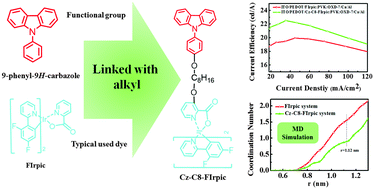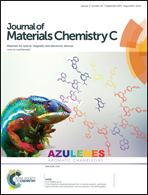Design, synthesis and characterization of a new blue phosphorescent Ir complex†
Abstract
Being incompatible with host materials in a physically blended emitting layer, phosphorescent dyes are prone to form aggregates induced by Joule heat in devices under work. In this work, a new and efficient blue phosphorescent dye Cz-C8-FIrpic was designed and synthesised by incorporating 9-phenyl-9H-carbazole into a commonly used blue emissive iridium complex bis(4,6-(difluorophenyl)pyridine-N,C2′)picolinate (FIrpic) via an alkyl chain linkage. This phosphorescent dye exhibits similar photophysical properties to the units of FIrpic and 9-phenyl-9H-carbazole in solutions. In solid films of Cz-C8-FIrpic, the energy transfer from 9-phenyl-9H-carbazole to FIrpic units is effective. The Cz-C8-FIrpic doped emissive layer was investigated by AFM, STEM-EDS, transient photoluminescence decay curves and molecular dynamics simulations. The results show that in the Cz-C8-FIrpic doped film the phase aggregation of FIrpic units is less severe than that in the typically used FIrpic film. In addition, the optimized Cz-C8-FIrpic based device achieved a maximum luminance of 25 142 cd m−2, a maximum EQE of 8.5% and a maximum current efficiency of 22.5 cd A−1 which is about 15% higher than that of the control device based on FIrpic. We conclude that grafting a typically used dye to functional groups with alkyl chains is useful to restrict phase separation in physically blended emitting layers, and thus can achieve high electroluminescence performances.


 Please wait while we load your content...
Please wait while we load your content...